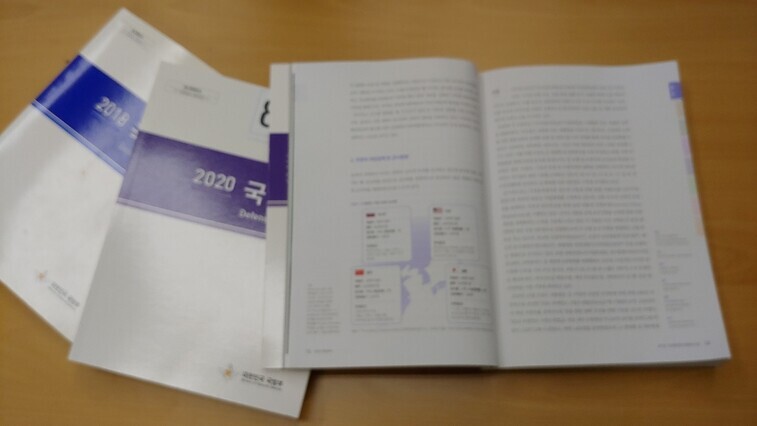hankyoreh
Links to other country sites 다른 나라 사이트 링크
S. Korean defense white paper lists Japan only as “neighbor,” not “partner”

South Korea’s defense white paper for 2020 strikes a reference to Japan as “partner,” listing it only as a “neighboring country.”
On Feb. 2, the Ministry of National Defense (MND) released the 2020 version of its defense white paper, which is published every other year. In it, Japan is referred to as a “neighboring country with whom we need to collaborate not only for the sake of bilateral relations, but also for peace and prosperity in Northeast Asia and the world.”
The latest version omits the characterization of Japan as a “partner” from the 2018 defense white paper, which said that “South Korea and Japan are both geographically and cultural close neighbors as well as partners who must cooperate for the sake of world peace and prosperity.”
The description appears to reflect the recent troubled situation in South Korea-Japan relations, which have reached an all-time low. Japan deliberately downplayed South Korea’s importance in its own 2020 defense white paper released last July, listing it fourth after Australia, India, and ASEAN among Tokyo’s counterparts in national security cooperation.
Commenting on the inter-Korean military agreement concluded on Sept. 19, 2018, the South Korean defense white paper said it had resulted in a “historic easing of military tensions between South and North.”
“In the past, the North Korean military had consistently conducted many artillery fire and field training exercises within 5km of the Military Demarcation Line (MDL), but none at all have been conducted since the Sept. 19 military agreement,” it observed.
Regarding the Demilitarized Zone, the white paper said there had been “no military tensions at all apart from the exchange of gunfire at a DMZ guard post in May 2020,” adding that there had been no instances of North Korean naval vessels crossing the Northern Limit Line (NLL) either.
An MND official said, “There have been [only] two cases of North Korea violating the Sept. 19 military agreement: its coastal artillery firing exercises on Changrin Island in Nov. 2019, and the DMZ guard post gunfire exchange in May 2020.”
In terms of North Korea’s nuclear capabilities, the white paper reiterated the assessment from its 2018 paper, which concluded that it possesses around 50kg of plutonium and a “substantial amount” of highly enriched uranium and has achieved a “substantial level” of nuclear weapon miniaturization capabilities.
Regarding the North’s missile capabilities, it said, “Since 2019, it has test-launched several types of solid-fuel short-range ballistic missiles, which are convenient to manage for operational purposes, as well as the Pukguksong-3, a new model of submarine-launched ballistic missile.”
The white paper further noted that nine types of ballistic missile had been observed at a military parade last October for the 75th anniversary of the Workers’ Party of Korea, including a new intercontinental ballistic missile and the Pukguksong-4.
The latest white paper did not include any characterization of North Korea as the South’s “enemy.” Like the 2018 version, it only stated that the South Korean military “considers as our enemy any forces that threaten and violate the Republic of Korea’s sovereignty, territory, people, and property,” without specifying North Korea or any other state.
Defense white papers have been issued every two years since 1967 for purposes including publicizing South Korea’s national defense policy. The latest edition was the 24th.
By Park Byong-su, editorial writer
Please direct comments or questions to [english@hani.co.kr]

Editorial・opinion
![[Column] Season 2 of special prosecutor probe may be coming to Korea soon [Column] Season 2 of special prosecutor probe may be coming to Korea soon](https://flexible.img.hani.co.kr/flexible/normal/500/300/imgdb/original/2024/0426/3317141030699447.jpg) [Column] Season 2 of special prosecutor probe may be coming to Korea soon
[Column] Season 2 of special prosecutor probe may be coming to Korea soon![[Column] Park Geun-hye déjà vu in Yoon Suk-yeol [Column] Park Geun-hye déjà vu in Yoon Suk-yeol](https://flexible.img.hani.co.kr/flexible/normal/500/300/imgdb/original/2024/0424/651713945113788.jpg) [Column] Park Geun-hye déjà vu in Yoon Suk-yeol
[Column] Park Geun-hye déjà vu in Yoon Suk-yeol- [Editorial] New weight of N. Korea’s nuclear threats makes dialogue all the more urgent
- [Guest essay] The real reason Korea’s new right wants to dub Rhee a founding father
- [Column] ‘Choson’: Is it time we start referring to N. Korea in its own terms?
- [Editorial] Japan’s rewriting of history with Korea has gone too far
- [Column] The president’s questionable capacity for dialogue
- [Column] Are chaebol firms just pizza pies for families to divvy up as they please?
- [Column] Has Korea, too, crossed the Rubicon on China?
- [Correspondent’s column] In Japan’s alliance with US, echoes of its past alliances with UK
Most viewed articles
- 1After election rout, Yoon’s left with 3 choices for dealing with the opposition
- 2AI is catching up with humans at a ‘shocking’ rate
- 3South Korea officially an aged society just 17 years after becoming aging society
- 4Noting shared ‘values,’ Korea hints at passport-free travel with Japan
- 51 in 5 unwed Korean women want child-free life, study shows
- 6Is Japan about to snatch control of Line messenger from Korea’s Naver?
- 7Why Kim Jong-un is scrapping the term ‘Day of the Sun’ and toning down fanfare for predecessors
- 8Two factors that’ll decide if Korea’s economy keeps on its upward trend
- 9[Column] ‘Choson’: Is it time we start referring to N. Korea in its own terms?
- 10Korea’s 1.3% growth in Q1 signals ‘textbook’ return to growth, says government